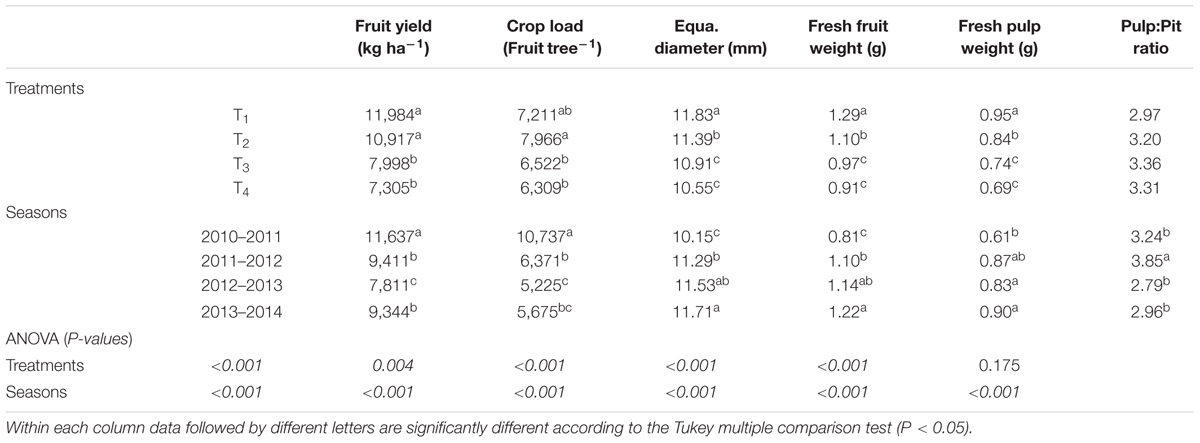- 1Research and Extension Center for Irrigation and Agroclimatology, Facultad de Ciencias Agraria, Universidad de Talca, Talca, Chile
- 2Research Program on Adaptation of Agriculture to Climate Change (A2C2), Universidad de Talca, Talca, Chile
- 3Centro Regional de Investigaciones Científicas y Transferencia Tecnológica de La Rioja – Consejo Nacional de Investigaciones Científicas y Técnicas, La Rioja, Argentina
- 4Departamento de Horticultura, Facultad de Ciencias Agraria, Universidad de Talca, Talca, Chile
An increase in the land area dedicated to super-high density olive orchards has occurred in Chile in recent years. Such modern orchards have high irrigation requirements, and optimizing water use is a priority. Moreover, this region presents low water availability, which makes necessary to establish irrigation strategies to improve water productivity. An experiment was conducted during four consecutive growing seasons (2010–2011 to 2013–2014) to evaluate the responses of yield and water productivity to irrigation cut-off strategies. These strategies were applied after fruit set using midday stem water potential (Ψstem) thresholds in a super-high density olive orchard (cv. Arbequina), located in the Pencahue Valley, Maule Region, Chile. The experimental design was completely randomized with four irrigation cut-off treatments based on the Ψstem thresholds and four replicate plots per treatment (five trees per plot). Similar to commercial growing conditions in our region, the Ψstem in the T1 treatment was maintained between -1.4 and -2.2 MPa (100% of actual evapotranspiration), while T2, T3 and T4 treatments did not receive irrigation from fruit set until they reached a Ψstem threshold of approximately -3.5, -5.0, and -6.0 MPa, respectively. Once the specific thresholds were reached, irrigation was restored and maintained as T1 in all treatments until fruits were harvested. Yield and its components were not significantly different between T1 and T2, but fruit yield and total oil yield, fruit weight, and fruit diameter were decreased by the T3 and T4 treatments. Moreover, yield showed a linear response with water stress integral (SΨ), which was strongly influenced by fruit load. Total oil content (%) and pulp/stone ratio were not affected by the different irrigation strategies. Also, fruit and oil water productivities were significantly greater in T1 and T2 than in the T3 and T4. Moreover, the T2, T3, and T4 treatments averaged 37, 51, and 72 days without irrigation which represented 75–83, 62–76, and 56–70% of applied water compared with T1, respectively. These results suggest that using the T2 irrigation cut-off strategy could be applied in a super-high density olive orchard (cv. Arbequina) because it maintained yields, saving 20% of the applied water.
Introduction
The olive tree (Olea europaea L.) is a characteristic species of the Mediterranean basin, which has traditionally been managed under dryland conditions. However, many studies have shown the benefits of irrigation on yield (Patumi et al., 2002; Moriana et al., 2003; Tognetti et al., 2007; Martín-Vertedor et al., 2011). For this reason, most of the commercial olive orchards in South America nowadays have been established at fairly high densities with drip-irrigation systems (Correa-Tedesco et al., 2010). Hedgerow orchards at super-high densities are also becoming a more common training system (Connor et al., 2014).
Despite yield gains at the farm level, increasing water scarcity in many regions has led to increased competition for water with non-agricultural users (Fereres et al., 2003). If less water is available, farmers should look toward increasing water productivity (production per unit of total water applied) through the optimization of irrigation management (Fereres and Evans, 2006; Iniesta et al., 2009; Fereres et al., 2014). For olive orchards, the regulated deficit irrigation (RDI) (Tognetti et al., 2005, 2007; Iniesta et al., 2009; Gómez del Campo and García, 2013) is the most commonly used irrigation strategy and consists of imposing water stress during phenological phases that are relatively insensitive to water deficit. Goldhamer (1999) reported that the pit hardening phase is the least sensitive to water deficit, and recommended the adoption of RDI, restricting irrigation during this phase. RDI strategies have achieved savings of around 20% of total water applied without reducing fruit yield (Goldhamer, 1999; Gómez-del-Campo, 2013). Additionally, these studies indicated that the oil content was not affected by the decrease in total amount of water applied. Moreover, Iniesta et al. (2009) observed that the water productivity for oil production was tripled when there was a 25% decrease in total applied water. Similarly, Correa-Tedesco et al. (2010) indicated that the greatest water productivity (21.3 kg mm-1 ha-1) was observed when applying water between 51 and 52% of actual evapotranspiration (ETc).
Traditionally, ETc is computed using grass reference evapotranspiration (ETo) multiplied by grass-reference-based crop-specific coefficients (Kc). ETo is estimated using the Penman–Monteith combination equation, but there is uncertainty on how to select the appropriate values of Kc. In this case, Kc values are empirical and often not adapted to local conditions (Ortega-Farias et al., 2009; Poblete-Echeverría and Ortega-Farías, 2013). The Kc in olive orchards depends on aspects of canopy architecture such as orientation (Connor et al., 2014), ground cover (Martínez-Cob and Faci, 2010), and the interactions of climatic conditions, soil type, cultivars and irrigation management practices (Ortega-Farías and López-Olivari, 2012). Due to this potential difficulty, recent research in olive trees has suggested using stem water potential (Ψstem) to monitor plant water status and for scheduling water application (Moriana et al., 2012). Despite that some studies indicate that plant water status measurements could be strongly affected by the environment, which would question their usefulness as an irrigation scheduling tool (Corell et al., 2016), the water potential is a measurement commonly used as a reference in the description of water stress level (Moriana et al., 2012).
Irrigation cut-off strategies using water potential thresholds have been suggested for several researchers in prune, vineyards, and olive orchards (Lampinen et al., 2001; Girona et al., 2006; Moriana et al., 2012; Trentacoste et al., 2015). These strategies consist of suppressing irrigation completely during a given phenological phase which is insensitive to water deficit, and reestablishing irrigation only when a threshold value of Ψstem is reached. These strategies are easy to use for most farmers, since little knowledge is necessary about olive physiology in response to water stress.
In the literature, there is little information regarding irrigation strategies using Ψstem in olive trees. Moriana et al. (2012) observed that fruit yield decreased 30% in olive trees (cv. Cornicabra) that were irrigated when Ψstem fell below -2.0 MPa versus trees that were irrigated based on a -1.2 MPa threshold. Also, Fernandes-Silva et al. (2010) observed that olive trees (cv. Cobrancosa) irrigated when Ψstem reached -6.0 MPa had reductions greater than 50% in comparison with that of trees maintained under a Ψstem of around -3.0 MPa throughout the season. Ghrab et al. (2013) observed that the dry olive weight decreased significantly with Ψstem around -3.0 MPa. However, fruit yield for olive trees (cv. Frantoio) irrigated when the Ψstem dropped below -2.5 MPa, was statistically similar to the control (Ψstem threshold between -1.2 and -1.5 MPa) (Trentacoste et al., 2015). Correa-Tedesco et al. (2010) indicated that water deficit (Ψstem = -2.5 MPa) did not affect fruit weight. According to Dell’Amico et al. (2012), the lower yields can be attributed to the effect of water stress on fruit size. Finally, the effect of water deficit on yields depends on crop load, and is much more sensitive in years of high olive fruit load (Martín-Vertedor et al., 2011). This generates uncertainty regarding the use of Ψstem thresholds for irrigation in super-high density olive orchards (Naor et al., 2013). Due to these uncertainties, the objective of this study was to evaluate the yield and water productivity responses to irrigation cut-off strategies applied after fruit set using Ψstem thresholds in a super-high density olive orchard (cv. Arbequina).
Materials and Methods
Site Description and Experimental Design
The experiment was conducted during four consecutive growing seasons (2010–2011 to 2013–2014) in a 6-year-old drip-irrigated olive orchard (O. europaea L. cv. Arbequina), established in 2005 and located in the Pencahue Valley, Maule Region, Chile (35°, 232′ L.S; 71° 442′ W; 96 m altitude). The olive trees were trained under a hedgerow system with a planting density of 1333 tree ha-1 (1.5 × 5.0 m), and irrigated using two 2.0 L h-1 drippers per tree. The olive orchard was weekly irrigated from October to April based on ETc. The climate is Mediterranean with an annual rainfall of 620 mm, concentrated in the winter period (Ortega-Farías and López-Olivari, 2012). The soil texture is clay-loam (31% clay, 29% sand, and 40% silt), with a bulk density of 1.34 g cm-3, a field capacity of 0.31 cm3 cm-3, and a wilting point of 0.16 cm3 cm-3.
The irrigation requirements were calculated using the standard FAO56 formula for crop evapotranspiration (ETc = ETo × Kc) where ETo is the reference evapotranspiration estimated using the Penman–Monteith equation over grass (Ortega-Farías et al., 1995; Allen et al., 1998) and Kc is the crop coefficient. Climate data for determining ETo [temperature, relative humidity (RH), solar radiation, and wind speed] were obtained from an automatic meteorological station (AMS) installed at a reference grass area, located about 2 km SE from the experimental site. Moreover, effective rainfall (R) was calculated as R = (Pp - 5)∗0.75, where Pp = rainfall obtained from the AMS.
The experimental design was completely randomized with four treatments and four replications (five trees per replication). In treatment T1, the irrigation was calculated applying 100% of the ETc. In this case, crop coefficients (between 0.56 and 0.42) were obtained from López-Olivari et al. (2016). This treatment maintained a Ψstem value around -2.2 MPa during the months of maximum water demand. In other treatments, irrigation was cut-off from fruit set (20 days after full bloom) until reaching Ψstem thresholds of approximately -3.5 MPa in T2, -5.0 MPa in T3, and -6.0 MPa in T4 (Fernandes-Silva et al., 2010; Flores and Ortega-Farias, 2011). Once the specific thresholds were reached, the irrigation was reestablished in all treatments until fruits were harvested.
The phenological stages were determined according to the BBCH scale (Sanz-Cortes et al., 2002). In this scale, the pit hardening period was determined when the pit became lignified (shows resistance to cutting). Fernández et al. (2013) also call this period the maximum rate of pit hardening. The end-pit-hardening was determined when it was no longer possible to cut the fruit.
Plant Water Status Measurements
The tree water status was monitored on a weekly basis using the midday stem water potential (Ψstem). These measurements were performed between 12:30 and 14:00 h (midday solar time) (Moriana and Fereres, 2002; Gómez-Del-Campo et al., 2008) using two apical shoots per plot of the current year with at least 10 leaves, located in the middle zone of the canopy (Secchi et al., 2007; Rousseaux et al., 2008). These stems were covered with a plastic bag and aluminum foil for 1–2 h (Meyer and Reicosky, 1985) prior to measurements carried out using a Scholander-type pressure chamber (PMS Instrument Company, Model 1000 Pressure Chamber Instrument) (Scholander et al., 1965).
In order to describe the accumulated effect of the irrigation cut-off strategies, the water stress integral (SΨ) was calculated as proposed by Myers (1988):
where Ψstem is the average stem water potential for any interval (MPa), c is the value of the maximum stem water potential during the season, and n is the number of days in each interval (Moriana et al., 2007).
Yield and Yield Components
To estimate fruit yield (kg ha-1), four trees from each plot were harvested manually on 130, 131, 134, and 127 DOY in 2011, 2012, 2013, and 2014, respectively. A sample of 50 olives from each replication was taken to measure their equatorial diameter as well as fruit weight, fresh pulp weight, and pulp/pit ratio using a precision balance. The total fruit number per tree was calculated by dividing the fruit yield of each tree by the individual fruit weight obtained previously (Patumi et al., 2002; Martín-Vertedor et al., 2011). Total oil content was determined following the official methods of AOAC using the Soxhlet method (Martín-Vertedor et al., 2011). This method extracted the oil by chemical methods and obtained all the lipids in the fruit. Total oil content was expressed on a dry weight basis (% d.w.). Water productivity was calculated as the ratio between fresh fruit yield (WPf) or total oil yield (WPo) per total water applied (irrigation + effective rainfall) during the growing season (Fernandes-Silva et al., 2013).
Statistical Analysis
Treatment effects were evaluated by analysis of variance (ANOVA) using the statistical software Infostat (Universidad Nacional de Córdoba, Argentina). The significant differences among the treatments were assessed using Tukey’s multiple range test (P < 0.05). A regression analysis was performed to determine the relationship between water stress integral and fruit and oil yield.
Results
Environmental Conditions of the Study
The daily mean RH values at our experimental site ranged between 64.9 and 69.8%, while those of air temperature were between 15.7 and 16.5 °C for the four growing seasons (September to April) (Table 1). In addition, the 2013–2014 growing season had a higher thermal oscillation with maximum and minimum values of 26.8 and 5.9°C, respectively. The total reference ETo was between 986 and 1,099 mm for the four growth seasons (September to April). Maximum ETo was observed during December and January with values ranging between 5.4 and 6.6 mm day-1. The accumulated effective rainfall was 84.9, 12.6, 76.2, and 41.3 mm for the 2010–2011, 2011–2012, 2012–2013, and 2013–2014 growing seasons, respectively. However, in all seasons, accumulated rainfall was less than 30 mm during the water deficit period (December to March) (Figure 1). Under these atmospheric conditions, the irrigation during the 2010–2011 growing season was less than that of the following three seasons (Figure 2). In this experiment, irrigation for the T2, T3, and T4 was between 75 and 83, 62 and 76, and 56 and 70% of the T1 treatment, respectively (Table 2).

TABLE 1. Mean values of relative humidity (RH), air temperature (T), and reference evapotranspiration (ETo) during September and April.
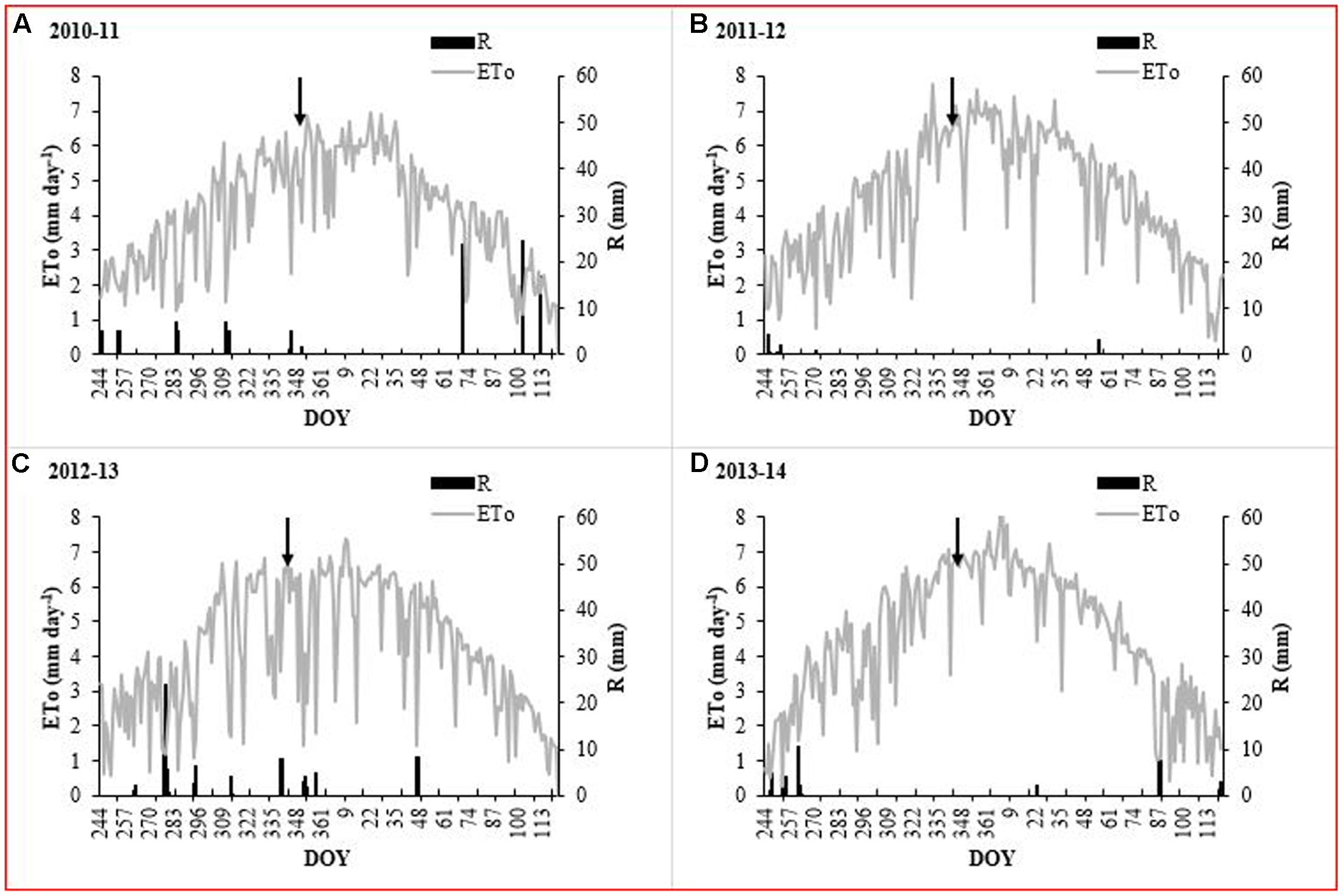
FIGURE 1. Reference evapotranspiration (ETo) and effective rainfall (R) during the 2010–2011, 2011–2012, 2012–2013 and 2013–2014 growing seasons (Pencahue Valley). The arrow indicates the beginning of the irrigation restriction of T2, T3 and T4.
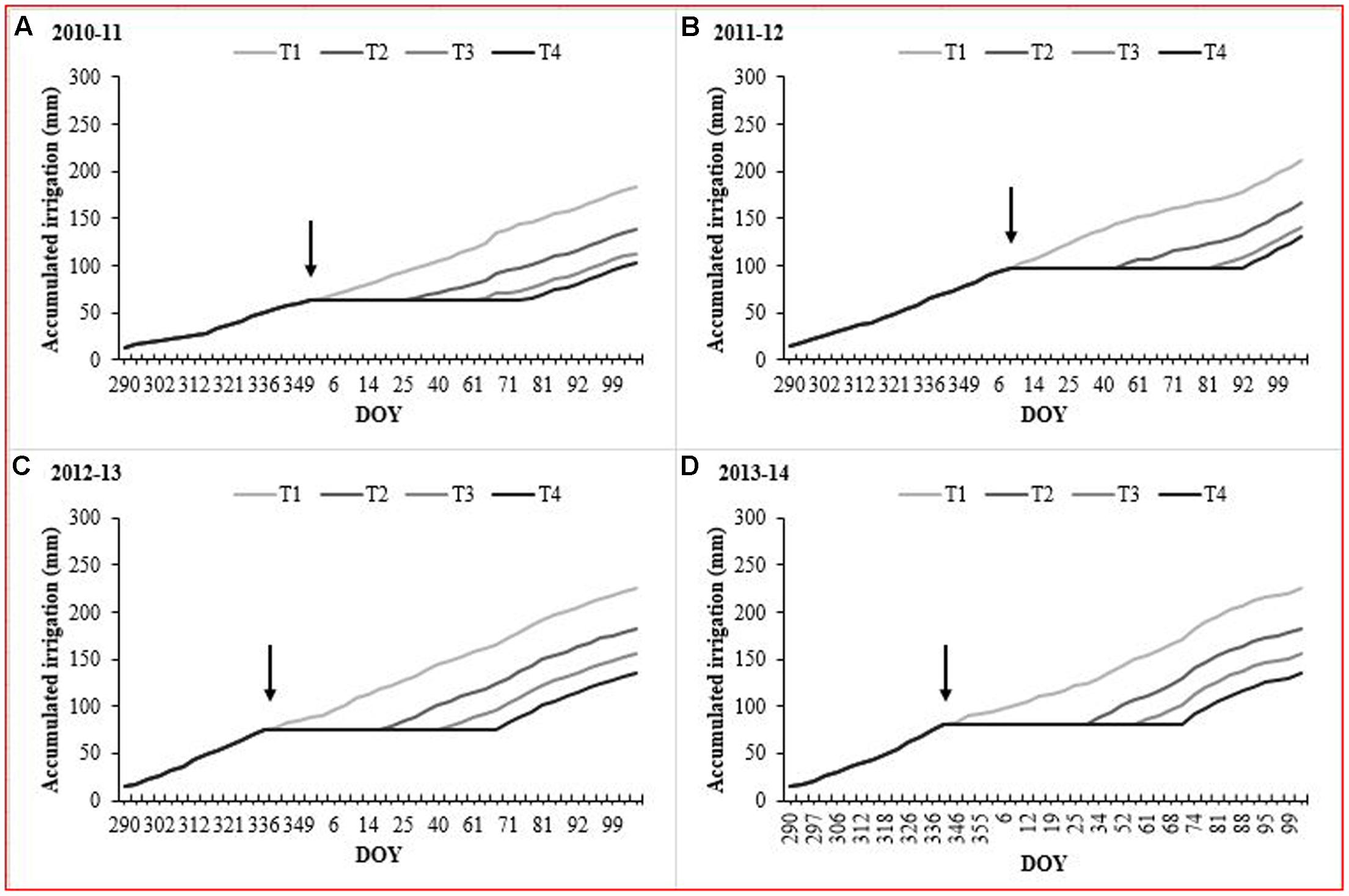
FIGURE 2. Accumulated irrigation (mm) of each treatments during the 2010–2011, 2011–2012, 2012–2013 and 2013–2014 growing seasons. The arrow indicates the beginning of the irrigation restriction of T2, T3 and T4.

TABLE 2. Irrigation and total water applied (mm ha-1) in each treatment during the 2010–2011, 2011–2012, 2012–2013, and 2013–2014 seasons.
Plant Water Status
At fruit set (i.e., the start of water restriction), there were no significant differences among treatments for the tree water status, with Ψstem values ranging between -1.41 and -1.48 (Table 3 and Figure 3). At the beginning of pit hardening (BPH), Ψstem values were lower in T2, T3, and T4 treatments than in the T1 treatment. Additionally, the T3 and T4 treatments had the lowest Ψstem at the BPH stage with -3.0 MPa, which were significantly lower than T2. At the end of pit hardening, on average there were no significant differences between the T1 and T2 treatments over the four growing seasons (Table 3) because the T2 treatments often reached the Ψstem threshold of -3.5 MPa (Figure 3), and the trees were re-watered (Table 4). The T3 and T4 treatments had lower values of Ψstem than the other treatments at the end of pit hardening because they had not reached their respective Ψstem thresholds (-5.0 and -6.0 MPa). The T3 treatment reached its Ψstem threshold between 49 and 53 days after the start of the irrigation cut-off, except for the 2012–2013 season (71 days; Table 4). The T4 treatment reached its threshold after 67–78 days for most years, but in the 2012–2013 season, it reached a minimum value of only -5.2 MPa after 97 days without irrigation. At harvest, values of Ψstem for all treatments ranged between -1.83 and -1.94 MPa with no significant differences among them. Finally, values of integral water stress (SΨ) of T1 and T2 treatments were significantly lower than those of T3 and T4. The minimum and maximum SΨ values were 100.99 and 255.36 MPa, respectively (Table 2). T4 showed the highest SΨ of all treatments.
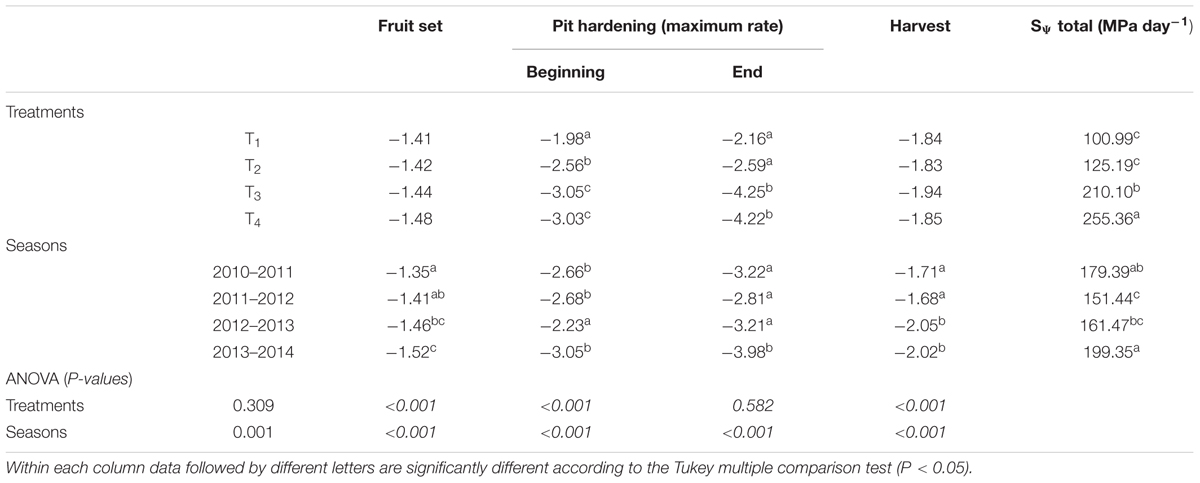
TABLE 3. Stem water potential (MPa) and water stress integral (SΨ) for a drip-irrigation olive orchard at super-high density.
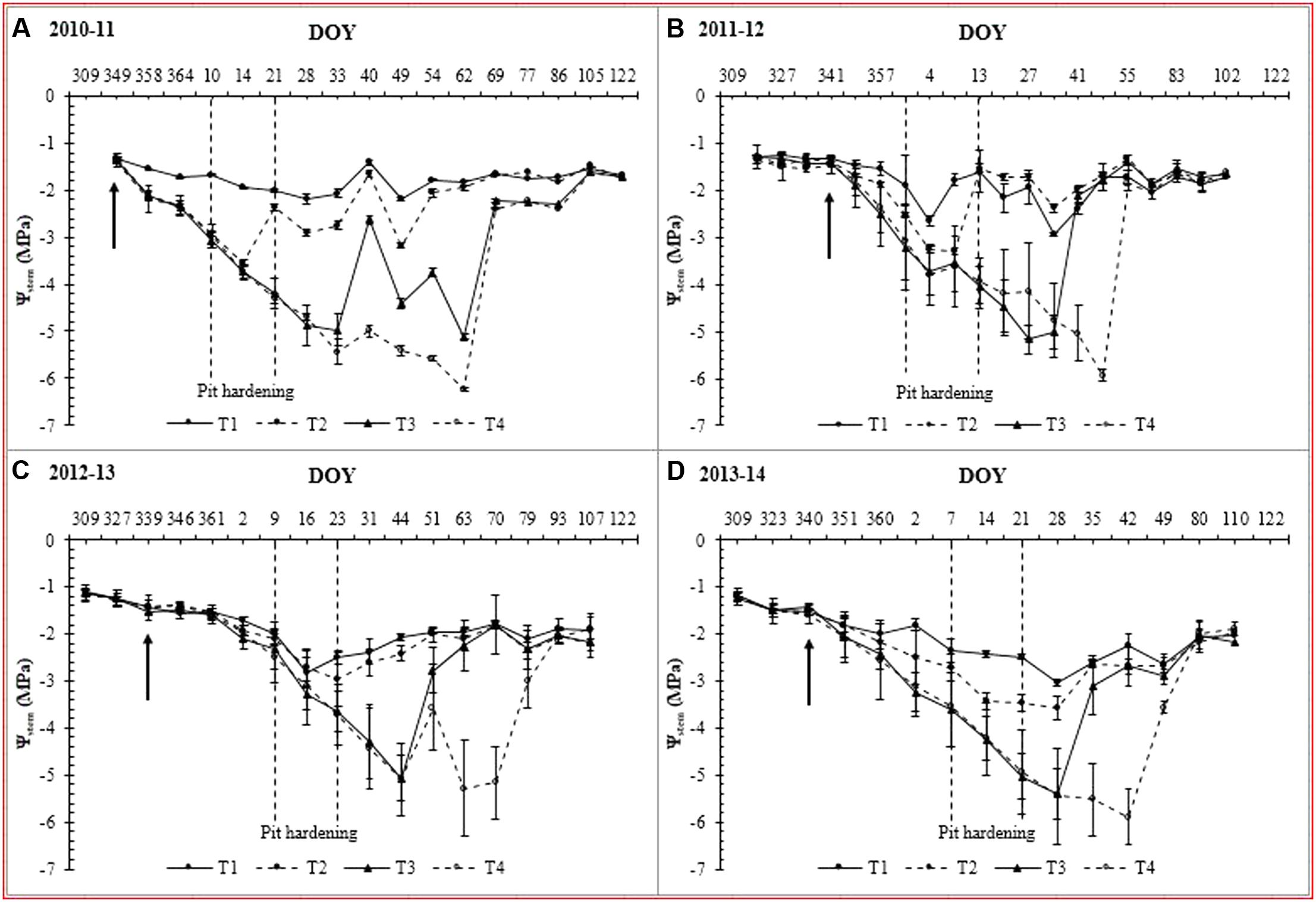
FIGURE 3. Evolution of midday stem water potential (Ψstem) of each treatments during the 2010–2011, 2011–2012, 2012–2013 and 2013–2014 growing seasons. The dashed lines represent the beginning and end pit hardening (maximum rate of pit hardening). The arrow indicates the beginning of the irrigation restriction of T2, T3 and T4.
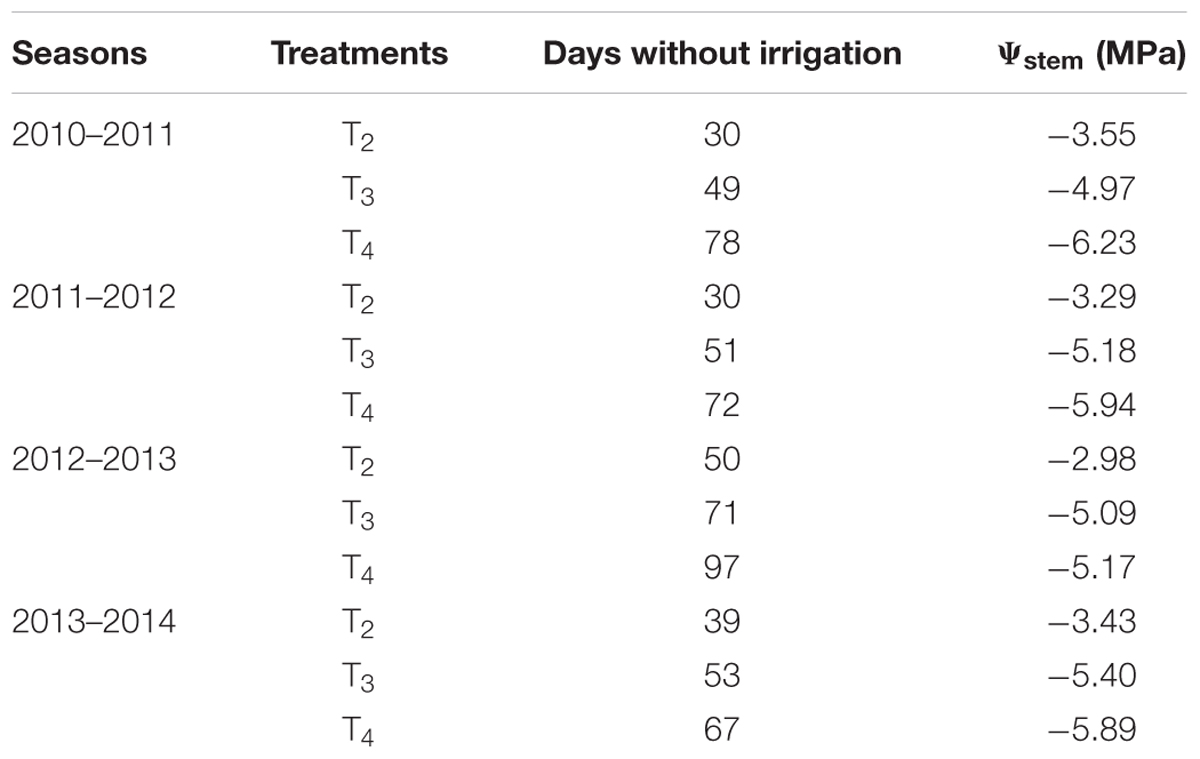
TABLE 4. Days without irrigation for the irrigation cut-off strategies treatments and the stem water potential (Ψstem) just before re-watering.
Yield and Yield Components
Average fruit yield in the four seasons was not significantly different between T1 and T2, with a yield of 11,984 and 10,917 kg ha-1, respectively (Table 5). However, both treatments had fruit yields significantly greater than those of the T3 and T4 treatments. Average crop load was greater in T2 (7,966 olives tree-1) compared to T3 and T4, but there was no significant difference between T1 and T2.
Yield components including equatorial diameter, fresh fruit weight, and fresh pulp were all affected by the irrigation cut-offs strategies (Table 5). They had their highest values in the T1 treatment and decreased progressively with increased water deficit, reaching their lowest values in T3 and T4. The pulp/pit ratio did not show significant differences among treatments with values ranging between 2.97 and 3.36.
Furthermore, there were significant differences between seasons for yield and its components. Fruit yield was greatest in the 2010–2011 season and lowest in the 2012–2013 season. Crop load had a similar pattern to yield, with the greatest crop load observed in the 2010–2011 season and the lowest crop loads occurring in the 2012–2013 and 2013–2014 seasons. The fruit equatorial diameter and individual fruit fresh weight were lower in the season with the highest crop load (2010–2011) and greater when the crop load was low (2012–2013 and 2013–2014 seasons). Fresh pulp weight was significantly less in the 2010–2011 season than in the other three seasons, and pulp/pit ratio was significantly higher in the 2011–2012 season.
Total Oil Content and Water Productivity
The average total oil content of treatments in the four seasons was between 46.7 and 50.2% (d.w.), but there were no significant differences among them (Table 6). Total oil yield reflected the fruit yield pattern, with the total oil yield being greater in the T1 and T2 treatments (2439 and 2199 kg ha-1, respectively) than in the T3 and T4 treatments (1,560 and 1,440 kg tree-1, respectively). The fruit (WPf) and oil (WPo) water productivities were significantly greater in the T1 and T2 than in the T3 and T4 treatments. It is important to indicate that WPo was calculated using total oil content obtained as fruit yield multiplied by % oil obtained from Soxhlet method (Fernandes-Silva et al., 2013).
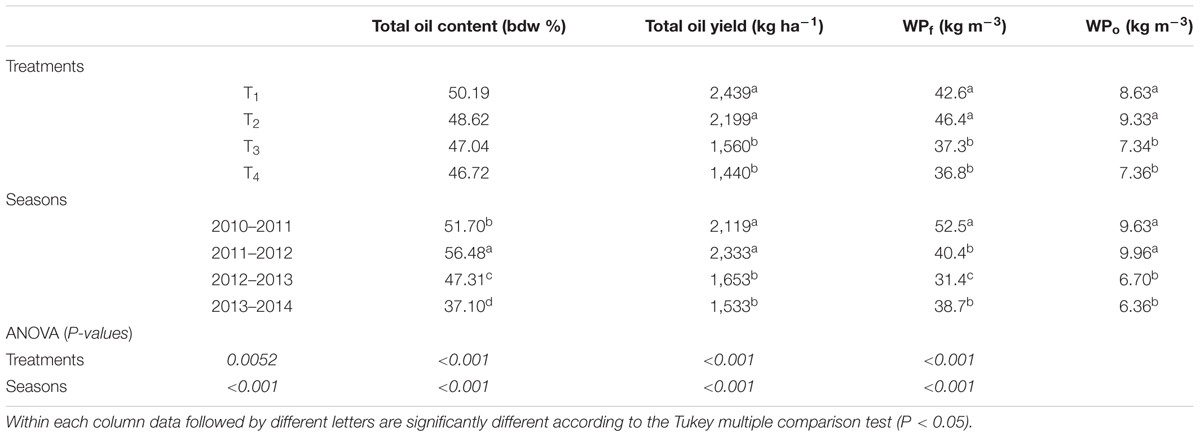
TABLE 6. Total oil content, oil yield, and fruit (WPf) and oil (WPo) water productivity for each treatment and growing season.
The highest total oil content occurred in the 2011–2012 season with an average of 56.5% and the lowest total oil content in the 2013–2014 season with 37.2%, while the total oil yield was significantly greater in 2010–2011 and 2011–2012 than in 2012–2013 and 2013–2014. The greatest WPf was found in the 2010–2011 season with 52.5 kg fruit mm-1 and the lowest was in the 2012–2013 season with 31.4 kg fruit mm-1. For WPo, the maximum values were observed in 2010–2011 and 2011–2012 (9.63 and 9.96 kg oil mm-1, respectively).
Discussion
Our region has a cool Mediterranean-type climate with about 620 mm of rainfall occurring during the winter months. During this study, weather behaved according to the expected conditions in the area, with maximum atmospheric demand during December and January. Due to low rainfall in summer, we found that irrigation was necessary to maintain fruit yield and total oil yield, and that irrigation cut-offs based on Ψstem thresholds was a practical and user-friendly method of scheduling irrigation in super-high density orchards. However, we recognize that optimal midday stem water potential may vary somewhat by region due to climate variables such as vapor pressure deficit and temperature (Corell et al., 2016), or due to soil type.
Irrigation of the T1 treatment averaged 230 mm over the four growing seasons. For these seasons, Ψstem mostly ranged between -1.4 and -2.0 MPa, indicating that trees were in a null to mild water stress condition. This can be established because despite that thresholds from -1.0 to -1.5 MPa have been suggested as adequate to satisfy olive tree water requirements (Dell’Amico et al., 2012), values lower than -2.0 MPa can occur even in well-watered trees during the summer under high vapor pressure deficits and high crop load conditions (Ben-Gal et al., 2010; Ortega-Farías and López-Olivari, 2012; Marra et al., 2016). The T2 treatment received an average of 185 mm per growing season, which was almost 20% less than the T1 treatment. This treatment reached its Ψstem threshold (-3.5 MPa) during pit hardening after an average of 37 days without irrigation (Table 4). Reducing irrigation during pit hardening has been recommended by many authors because this phase is the least sensitive to water deficit (Goldhamer, 1999; Alegre et al., 2002; Gómez del Campo and García, 2013). Also, the application of RDI during this phase could allow for considerable water savings because pit hardening generally coincides with high atmospheric demands for water vapor (Goldhamer, 1999). In our study, the pit hardening period (maximum rate) was reached during January, which coincides with the time of the year observed in previous seasons (López-Olivari et al., 2016). The T3 and T4 treatments received an average of 163 and 141 mm of irrigation per growing season, respectively, and reached their Ψstem thresholds post-pit hardening (post-maximum rate) after 56 and 72 days without irrigation. These thresholds (-5.0 MPa in T3 and -6.0 MPa in T4) suggest that the trees in the T3 and T4 treatments were severely stressed during the experiment (Moriana et al., 2002). Once irrigation was restored in the T2, T3, and T4 treatments, their Ψstem returned to values similar to those of the T1 treatment as has been observed by other authors (Dell’Amico et al., 2012; Agüero et al., 2016).
The orchard was severely pruned during the spring of the 2012–2013 season, which likely decreased the daily crop water requirements due to reduced leaf area per tree. This lower demand could explain the extended period without irrigation in the T2 and T3 treatments before reaching their Ψstem threshold in 2012–2013 (50 and 71 days in T2 and T3, respectively). In the case of the T4 treatment, the combination of spring pruning and rainfall in December (23.9 mm) resulted in the Ψstem threshold not being reached in the 2012–2013 season.
Despite receiving almost 20% less irrigation, fruit yield of the T2 treatment (10,917 kg ha-1) was not statistically lower than that of the T1 treatment (11,984 kg ha-1) for the four growing seasons. This suggests that this irrigation cut-off strategy could be applied in commercial orchards without affecting yield. In contrast, the fruit size was reduced by 15% (T2), although maximum water stress occurred after the vast majority of endocarp (pit) and mesocarp (pulp) cells were formed (Hammami et al., 2011). This reduction can be explained because fruit expansion requires an adequate flow of water to the fruit and sufficient turgor to drive in cell enlargement (Dell’Amico et al., 2012). These results are in accordance with Marra et al. (2016), who suggested maintaining Ψstem values between -3.5 and -2.5 MPa to get an optimal-moderate yield in olive cv. Arbequina.
Fruit yields for T3 and T4 treatments were 33 and 39% less than T1, respectively. These reductions were mainly due to a smaller crop load and lower fruit weight as has been reported by Fernandes-Silva et al. (2010) for severe water stress conditions. Crop load was reduced by 10–13% in T3 and T4 treatments, respectively, and fruit weight was reduced by 25–30%. This decrease in yield and their components can be explained by limitations to photosynthesis which are controlled by water stress (Angelopoulos et al., 1996; Flexas and Medrano, 2002). Indeed, the immediate response of plants to water stress is to limit leaf transpiration in order to reduce water loss through stomatal closure (Fernández et al., 1997). However, this also causes reduced CO2 diffusion into the leaf, thereby limiting carbon assimilation (Angelopoulos et al., 1996; Ennajeh et al., 2008).
Moreover, relative fruit yield showed a linear response with the minimum Ψstem during the seasons, despite that there was a high dispersion of data (Figure 4). However, an integrated plant water status is more appropriated for evaluating the effect of water deficit on fruit yield. Therefore, the SΨ was related to fruit yield and had a high linear correlation (Figure 5). These results coincide with those reported by Moriana et al. (2012) in olive trees cv. Cornicabra. However, in our results, this relationship was strongly influenced by fruit load. Thus, in the “on” years, the relationship was higher and presented a greater slope than in “off” years.
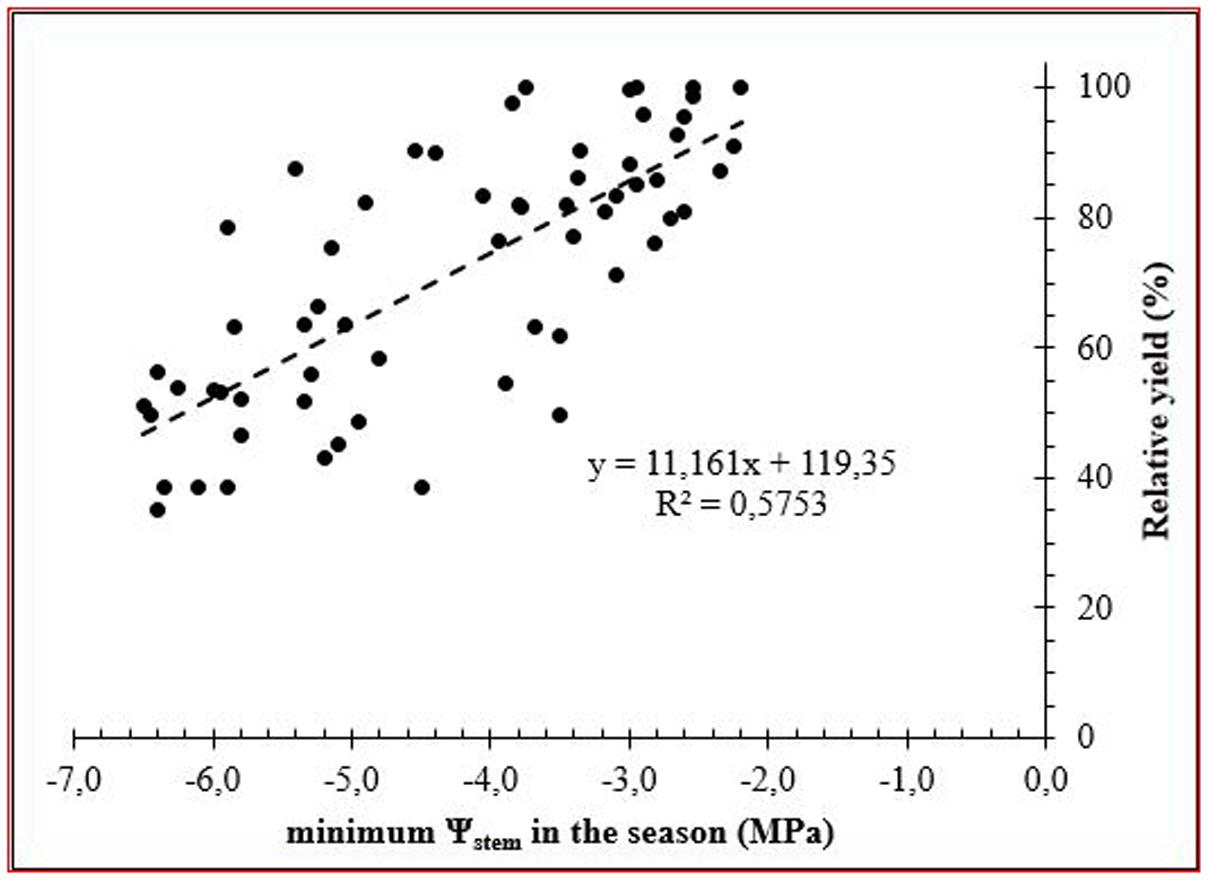
FIGURE 4. Relationship between minimum values of midday stem water potential (Ψstem) and relative yield during the study seasons.
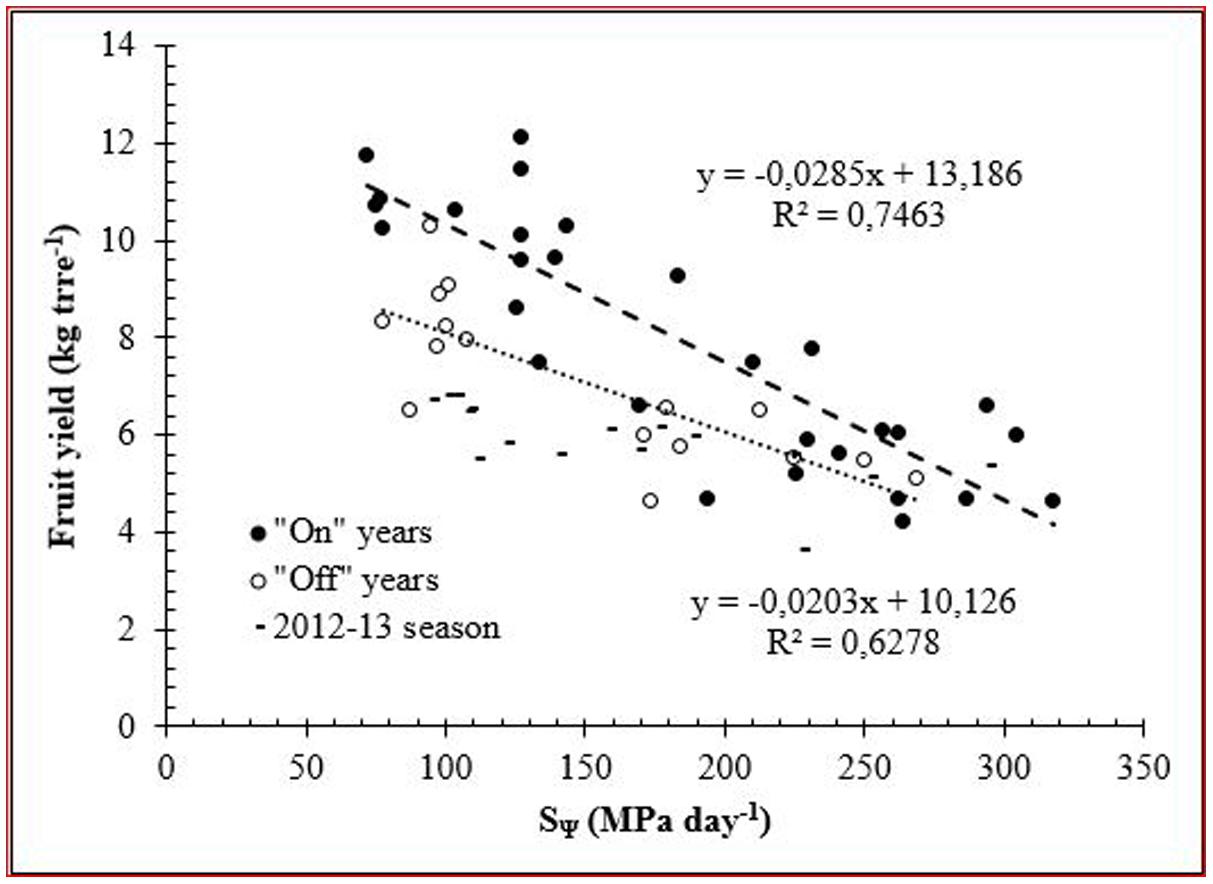
FIGURE 5. Relationship between integral water stress (SΨ) and fruit yield during the study seasons. On years: 2010–2011 and 2013–2014. Off years: 2011–2012.
Fruit yields of all treatments followed a biannual (alternate bearing) pattern with an “on” year in 2010–2011 and an “off” year in 2011–2012. Unfortunately, the pruning done in the 2012–2013 season prevented the assessment of alternate bearing in the last two seasons. Such a pattern is common in most olive cultivars (Lavee, 2007). This often occurs because in the “on” year there is low shoot growth, which leads to few potentially reproductive buds for the next year; when crop load is high there is inhibition of floral induction (Dag et al., 2010; Fernández et al., 2015). Consequently, the year-to-year variations in yield are directly related with fruit number per tree of each year (Martín-Vertedor et al., 2011; Trentacoste et al., 2015). Additionally, fruit size and fruit weight were lower in the seasons with higher crop loads. These results are explained by the close relationship between yield components and the number of olives per tree (Iniesta et al., 2009; Martín-Vertedor et al., 2011).
Water deficit treatments did not lead to any changes in total oil content (%). Therefore, the reductions in oil yield in the T3 and T4 treatments were related to crop load and fruit weight, rather than to total oil content itself. Total oil content on a dry weight basis appears to be fairly insensitive to water deficit (Patumi et al., 2002; Moriana et al., 2003; Tognetti et al., 2007; Iniesta et al., 2009; García et al., 2013). However, Trentacoste et al. (2015) found a significant reduction of 3.1% in total oil content using a -2.5 MPa irrigation threshold in cv. Frantoio. The lack of response of oil content (%) in many of these studies is likely a function of water deficit being implemented during the pit hardening period, rather than later when most oil accumulation occurs. Moreover, total oil content was significantly lower in the 2010–2011 season compared to other seasons. In this case, air temperature (minimum and maximum) and maturity index (MI) were lower during April 2011 (40 days before harvest) than in other years. In this case, the MI were 1.56, 1.69, 1.56, and 1.11 for 2010–2011, 2011–2012, 2012–2013, and 2013–2014, respectively. These results coincide with those observed by Motilva et al. (2000) and Grattan et al. (2006) who suggest that total oil content is highly related to MI.
Despite T2 receiving almost 20% less irrigation, no significant differences in WPf and WPo were found between the T1 and T2 treatments. In contrast, WP decreased for both fruit and oil yield under severe water stress in the T3 and T4 treatments. Thus, the WP responses would be explained by the difference in the intensity of water deficit treatments. The decrease in WPf and WPo under severe stress is consistent with the results of Fernandes-Silva et al. (2010) in olive cv Cobrançosa where water potential also reached around -6.0 MPa. Some studies have reported an increase in WPf under moderate stress conditions with Ψstem values similar to those observed with the T2 treatment (Marra et al., 2016). It may be that an intermediate Ψstem threshold between our T2 and the T3 and T4 treatments may have led to a significant increase in WPf and WPo.
Conclusion
Results obtained in the present study over four growing seasons showed that yields were not affected when irrigation cut-off was applied from fruit set until reaching a threshold level of -3.5 MPa (T2 treatment) around massive pit hardening compared to T1 (100% ETc). This provides evidence that this period is not overly sensitive to moderate water stress. However, yield and its components were severely affected when using Ψstem thresholds of -5.0 (T3) and -6.0 (T4) MPa. Also, the total oil content (%) and pulp/pit ratio were not affected by the different irrigation cut-off strategies. Moreover, the fruit and oil water productivities were significantly greater in T2 compared to T3 and T4 treatments.
In summary, these results suggest that the T2 irrigation cut-off strategy would be the most appropriate, because this treatment maintained fruit and oil yield, saving 20% of the total water applied. These results suggest that this strategy (T2) is a viable strategy to be implemented in high-density olive orchards in climates similar to the one where this research was done.
Author Contributions
Conceived and designed the experiments: SO-F and LA-O. Performed the evaluations: LA-O. Analyzed the data: SO-F, LA-O, PS, and JR. Wrote the paper: LA-O, SO-F, PS, and JR. Implemented reviewers comments: SO-F, LA-O, PS, and JR.
Funding
This study was supported by the Chilean government through the projects CONICYT “Programa Formación de Capital Humano Avanzado” (N° 21120443), FONDECYT (N° 1130729), and FONDEF (N° D10I1157).
Conflict of Interest Statement
The authors declare that the research was conducted in the absence of any commercial or financial relationships that could be construed as a potential conflict of interest.
Acknowledgments
The authors would like to thank Manuel Barrera and Alvaro Ried from the “Olivares de Quepu” Company for their technical support and for allowing to set up the trials in the company’s orchards.
References
Agüero, L. M., Rousseaux, M. C., and Searles, P. S. (2016). Responses of several soil and plant indicators to post-harvest regulated deficit irrigation in olive trees and their potential for irrigation scheduling. Agric. Water Manag. 171, 10–20. doi: 10.1016/j.agwat.2016.03.006
Alegre, S., Marsal, J., Mata, M., Arbonés, A., Girona, J., and Tovar, M. J. (2002). Regulated deficit irrigation in olive trees (Olea europaea L. cv. Arbequina) for oil production. Acta Hortic. 586, 259–262. doi: 10.17660/ActaHortic.2002.586.49
Allen, R. G., Pereira, L. S., Raes, D., and Smith, M. (1998). Crop Evapotranspiration - Guidelines for Computing Crop Water Requirements - FAO Irrigation and Drainage Paper 56. Rome: FAO.
Angelopoulos, K., Dichio, B., and Xiloyannis, C. (1996). Inhibition of photosynthesis in olive trees (Olea europaea L.) during water stress and rewatering. J. Exp. Bot. 47, 1093–1100. doi: 10.1093/jxb/47.8.1093
Ben-Gal, A., Kool, D., Agam, N., van Halsema, G. E., Yermiyahu, U., Yafe, A., et al. (2010). Whole-tree water balance and indicators for short-term drought stress in non-bearing “Barnea” olives. Agric. Water Manag. 98, 124–133. doi: 10.1016/j.agwat.2010.08.008
Connor, D. J., Gómez-del-Campo, M., Rousseaux, M. C., and Searles, P. S. (2014). Structure, management and productivity of hedgerow olive orchards: a review. Sci. Hortic. 169, 71–93. doi: 10.1016/j.scienta.2014.02.010
Corell, M., Pérez-López, D., Martín-Palomo, M. J., Centeno, A., Girón, I., Galindo, A., et al. (2016). Comparison of the water potential baseline in different locations. Usefulness for irrigation scheduling of olive orchards. Agric. Water Manag. 177, 308–316. doi: 10.1016/j.agwat.2016.08.017
Correa-Tedesco, G., Rousseaux, M. C., and Searles, P. S. (2010). Plant growth and yield responses in olive (Olea europaea) to different irrigation levels in an arid region of Argentina. Agric. Water Manag. 97, 1829–1837. doi: 10.1016/j.agwat.2010.06.020
Dag, A., Bustan, A., Avni, A., Tzipori, I., Lavee, S., and Riov, J. (2010). Timing of fruit removal affects concurrent vegetative growth and subsequent return bloom and yield in olive (Olea europaea L.). Sci. Hortic. 123, 469–472. doi: 10.1016/j.scienta.2009.11.014
Dell’Amico, J., Moriana, A., Corell, M., Girón, I. F., Morales, D., Torrecillas, A., et al. (2012). Low water stress conditions in table olive trees (Olea europaea L.) during pit hardening produced a different response of fruit and leaf water relations. Agric. Water Manag. 114, 11–17. doi: 10.1016/j.agwat.2012.06.004
Ennajeh, M., Tounekti, T., Vadel, A. M., Khemira, H., and Cochard, H. (2008). Water relations and drought-induced embolism in olive (Olea europaea) varieties “Meski” and “Chemlali” during severe drought. Tree Physiol. 28, 971–976. doi: 10.1093/treephys/28.6.971
Fereres, E., and Evans, R. G. (2006). Irrigation of fruit trees and vines: an introduction. Irrig. Sci. 24, 55–57. doi: 10.1007/s00271-005-0019-3
Fereres, E., Goldhamer, D. A., and Parsons, L. R. (2003). Irrigation water management of horticultural crops. HortScience 38, 1036–1042.
Fereres, E., Orgaz, F., Gonzalez-Dugo, V., Testi, L., and Villalobos, F. J. (2014). Balancing crop yield and water productivity tradeoffs in herbaceous and woody crops. Funct. Plant Biol. 41, 1009–1018. doi: 10.1071/FP14042
Fernandes-Silva, A. A., Ferreira, T. C., Correia, C. M., Malheiro, A. C., and Villalobos, F. J. (2010). Influence of different irrigation regimes on crop yield and water use efficiency of olive. Plant Soil 333, 35–47. doi: 10.1007/s11104-010-0294-5
Fernandes-Silva, A. A., Gouveia, J. B., Vasconcelos, P., Ferreira, T. C., and Villalobos, F. J. (2013). Effect of different irrigation regimes on the quality attributes of monovarietal virgin olive oil from cv. “Cobrançosa”. Grasas Aceites 64, 41–49. doi: 10.3989/gya.070512
Fernández, F. J., Ladux, J. L., and Searles, P. S. (2015). Dynamics of shoot and fruit growth following fruit thinning in olive trees: same season and subsequent season responses. Sci. Hortic. 192, 320–330. doi: 10.1016/j.scienta.2015.06.028
Fernández, J. E., Moreno, F., Girón, I. F., and Blázquez, O. M. (1997). Stomatal control of water use in olive tree leaves. Plant Soil 190, 179–192. doi: 10.1023/A:1004293026973
Fernández, J. E., Perez-Martin, A., Torres-Ruiz, J. M., Cuevas, M. V., Rodriguez-Dominguez, C. M., Elsayed-Farag, S., et al. (2013). A regulated deficit irrigation strategy for hedgerow olive orchards with high plant density. Plant Soil 372, 279–295. doi: 10.1002/jsfa.7828
Flexas, J., and Medrano, H. (2002). Drought-inhibition of photosynthesis in C3 plants: stomatal and non-stomatal limitations revisited. Ann. Bot. 89, 183–189. doi: 10.1093/aob/mcf027
Flores, F., and Ortega-Farias, S. (2011). Effect of three levels of water application on oil yield and quality for an olive (‘Picual’) orchard. Acta Hortic. 889, 317–322. doi: 10.17660/ActaHortic.2011.889.38
García, J. M., Cuevas, M. V., and Fernández, J. E. (2013). Production and oil quality in “Arbequina” olive (Olea europaea, L.) trees under two deficit irrigation strategies. Irrig. Sci. 31, 359–370. doi: 10.1007/s00271-011-0315-z
Ghrab, M., Gargouri, K., Bentaher, H., Chartzoulakis, K., Ayadi, M., Ben Mimoun, M., et al. (2013). Water relations and yield of olive tree (cv. Chemlali) in response to partial root-zone drying (PRD) irrigation technique and salinity under arid climate. Agric. Water Manag. 123, 1–11. doi: 10.1016/j.agwat.2013.03.007
Girona, J., Mata, M., Del Campo, J., Arbonés, A., Bartra, E., and Marsal, J. (2006). The use of midday leaf water potential for scheduling deficit irrigation in vineyards. Irrig. Sci. 24, 115–127. doi: 10.1007/s00271-005-0015-7
Goldhamer, D. A. (1999). Regulated deficit irrigation for California canning olives. Acta Hortic. 474, 369–372. doi: 10.17660/ActaHortic.1999.474.76
Gómez del Campo, M., and García, J. M. (2013). Summer deficit-irrigation strategies in a hedgerow olive cv. Arbequina Orchard: effect on oil quality. J. Agric. Food Chem. 61, 8899–8905. doi: 10.1021/jf402107t
Gómez-del-Campo, M. (2013). Summer deficit irrigation in a hedgerow olive orchard cv. Arbequina: relationship between soil and tree water status, and growth and yield components. Spanish J. Agric. Res. 11, 547–557. doi: 10.1021/jf402107t
Gómez-Del-Campo, M., Leal, A., and Pezuela, C. (2008). Relationship of stem water potential and leaf conductance to vegetative growth of young olive trees in a hedgerow orchard. Aust. J. Agric. Res. 59, 270–279. doi: 10.1071/AR07200
Grattan, S. R., Berenguer, M. J., Connell, J. H., Polito, V. S., and Vossen, P. M. (2006). Olive oil production as influenced by different quantities of applied water. Agric. Water Manag. 85, 133–140. doi: 10.1016/j.agwat.2006.04.001
Hammami, S. B. M., Manrique, T., and Rapoport, H. F. (2011). Cultivar-based fruit size in olive depends on different tissue and cellular processes throughout growth. Sci. Hortic. 130, 445–451. doi: 10.1016/j.scienta.2011.07.018
Iniesta, F., Testi, L., Orgaz, F., and Villalobos, F. J. (2009). The effects of regulated and continuous deficit irrigation on the water use, growth and yield of olive trees. Eur. J. Agron. 30, 258–265. doi: 10.1016/j.eja.2008.12.004
Lampinen, B. D., Shackel, K. A., Southwick, S. M., and Olson, W. H. (2001). Deficit irrigation strategies using midday stem water potential in prune. Irrig. Sci. 20, 47–54. doi: 10.1007/s002710000028
Lavee, S. (2007). Biennal bearing in olive (Olea europaea L.). Olea 17, 101–112. doi: 10.3389/fpls.2016.01226
López-Olivari, R., Ortega-Farías, S., and Poblete-Echeverría, C. (2016). Partitioning of net radiation and evapotranspiration over a superintensive drip-irrigated olive orchard. Irrig. Sci. 34, 17–31. doi: 10.1007/s00271-015-0484-2
Marra, F. P., Marino, G., Marchese, A., and Caruso, T. (2016). Effects of different irrigation regimes on a super-high-density olive grove cv. “ Arbequina ”: vegetative growth, productivity and polyphenol content of the oil. Irrig. Sci. 34, 313–325. doi: 10.1007/s00271-016-0505-9
Martínez-Cob, A., and Faci, J. M. (2010). Evapotranspiration of an hedge-pruned olive orchard in a semiarid area of NE Spain. Agric. Water Manag. 97, 410–418. doi: 10.1016/j.agwat.2009.10.013
Martín-Vertedor, A. I., Rodríguez, J. M. P., Losada, H. P., and Castiel, E. F. (2011). Interactive responses to water deficits and crop load in olive (Olea europaea L., cv. Morisca). II: water use, fruit and oil yield. Agric. Water Manag. 98, 950–958. doi: 10.1016/j.agwat.2011.01.003
Meyer, W. S., and Reicosky, D. C. (1985). Enclosing leaves for water potential measurement and its effect on interpreting soil-induced water stress. Agric. For. Meteorol. 35, 187–192. doi: 10.1016/0168-1923(85)90083-8
Moriana, A., and Fereres, E. (2002). Plant indicators for scheduling irrigation of young olive trees. Irrig. Sci. 21, 83–90. doi: 10.1007/s00271-001-0053-8
Moriana, A., Orgaz, F., Pastor, M., and Fereres, E. (2003). Yield responses of a mature olive orchard to water deficits. J. Am. Soc. Hortic. Sci. 128, 425–431.
Moriana, A., Pérez-López, D., Gómez-Rico, A., de los Salvador, M., Olmedilla, N., Ribas, F., et al. (2007). Irrigation scheduling for traditional, low-density olive orchards: Water relations and influence on oil characteristics. Agric. Water Manag 87, 171–179. doi: 10.1016/j.agwat.2006.06.017
Moriana, A., Pérez-López, D., Prieto, M. H., Ramírez-Santa-Pau, M., and Pérez-Rodriguez, J. M. (2012). Midday stem water potential as a useful tool for estimating irrigation requirements in olive trees. Agric. Water Manag. 112, 43–54. doi: 10.1016/j.agwat.2012.06.003
Moriana, A., Villalobos, F. J., and Fereres, E. (2002). Stomatal and photosynthetic responses of olive (Olea europaea L.) leaves to water deficits. Plant. Cell Environ. 25, 395–405. doi: 10.1046/j.0016-8025.2001.00822.x
Motilva, M. J., Tovar, M. J., Romero, M. P., Alegre, S., and Girona, J. (2000). Influence of regulated deficit irrigation strategies applied to olive trees (Arbequina cultivar) on oil yield and oil composition during the fruit ripening period. J. Sci. Food Agric. 80, 2037–2043. doi: 10.1002/1097-0010(200011)80:14<2037::AID-JSFA733>3.0.CO;2-0
Myers, B. J. (1988). Water stress integral-a link between short-term stress and long-term growth. J. Chem. Inf. Model. 53, 315–323. doi: 10.1093/treephys/4.4.315
Naor, A., Schneider, D., Ben-Gal, A., Zipori, I., Dag, A., Kerem, Z., et al. (2013). The effects of crop load and irrigation rate in the oil accumulation stage on oil yield and water relations of “Koroneiki” olives. Irrig. Sci. 31, 781–791. doi: 10.1007/s00271-012-0363-z
Ortega-Farías, S., Cuenca, R. H., and English, M. (1995). Hourly grass evapotranspiration in modified maritime environment. J. Irrig. Drain. Eng. 121, 369–373. doi: 10.1061/(ASCE)0733-9437(1995)121:6(369)
Ortega-Farias, S., Irmak, S., and Cuenca, R. H. (2009). Special issue on evapotranspiration measurement and modeling. Irrig. Sci. 28, 1–3. doi: 10.1007/s00271-009-0184-x
Ortega-Farías, S., and López-Olivari, R. (2012). Validation of a two-layer model to estimate latent heat flux and evapotranspiration in a drip-irrigated olive orchard. Am. Soc. Agric. Biol. Eng. 55, 1169–1178. doi: 10.13031/2013.42237
Patumi, M., D’Andria, R., Marsilio, V., Fontanazza, G., Morelli, G., and Lanza, B. (2002). Olive and olive oil quality after intensive monocone olive growing (Olea europaea L., cv. Kalamata) in different irrigation regimes. Food Chem. 77, 27–34. doi: 10.1016/S0308-8146(01)00317-X
Poblete-Echeverría, C., and Ortega-Farías, S. (2013). Evaluation of single and dual crop coefficients over a drip-irrigated Merlot vineyard (Vitis vinifera L.) using combined measurements of sap flow sensors and an eddy covariance system. Aust. J. Grape Wine Res. 19, 249–260. doi: 10.1111/ajgw.12019
Rousseaux, M. C., Benedetti, J. P., and Searles, P. S. (2008). Leaf-level responses of olive trees (Olea europaea) to the suspension of irrigation during the winter in an arid region of Argentina. Sci. Hortic. 115, 135–141. doi: 10.1016/j.scienta.2007.08.005
Sanz-Cortes, F., Martinez-Calvo, J., Badenes, M., Bleiholder, H., Hack, H., Llacer, G., et al. (2002). Phenological growth stages of olive trees (Olea europaea). Ann. Appl. Biol. 140, 151–157. doi: 10.1111/j.1744-7348.2002.tb00167.x
Scholander, P. F., Bradstreet, E. D., Hemmingsen, E. A., and Hammel, H. T. (1965). Sap pressure in vascular plants. Science 148, 339–346. doi: 10.1126/science.148.3668.339
Secchi, F., Lovisolo, C., and Schubert, A. (2007). Expression of OePIP2.1 aquaporin gene and water relations of Olea europaea twigs during drought stress and recovery. Ann. Appl. Biol. 150, 163–167. doi: 10.1111/j.1744-7348.2007.00118.x
Tognetti, R., D’Andria, R., Morelli, G., and Alvino, A. (2005). The effect of deficit irrigation on seasonal variations of plant water use in Olea europaea L. Plant Soil 273, 139–155. doi: 10.1007/s11104-004-7244-z
Tognetti, R., D’Andria, R., Sacchi, R., Lavini, A., Morelli, G., and Alvino, A. (2007). Deficit irrigation affects seasonal changes in leaf physiology and oil quality of Olea europaea (cultivars Frantoio and Leccino). Ann. Appl. Biol. 150, 169–186. doi: 10.1111/j.1744-7348.2007.00117.x
Keywords: Olea europaea, deficit irrigation, plant water status, yield components, total oil yield
Citation: Ahumada-Orellana LE, Ortega-Farías S, Searles PS and Retamales JB (2017) Yield and Water Productivity Responses to Irrigation Cut-off Strategies after Fruit Set Using Stem Water Potential Thresholds in a Super-High Density Olive Orchard. Front. Plant Sci. 8:1280. doi: 10.3389/fpls.2017.01280
Received: 04 March 2017; Accepted: 06 July 2017;
Published: 21 July 2017.
Edited by:
Luis Rallo, University of Córdoba, ColombiaReviewed by:
Alfonso Moriana, University of Seville, SpainMauro Centritto, Trees and Timber Institute (CNR), Italy
Jose Enrique Fernandez, Institute of Natural Resources and Agrobiology of Seville (CSIC), Spain
Copyright © 2017 Ahumada-Orellana, Ortega-Farías, Searles and Retamales. This is an open-access article distributed under the terms of the Creative Commons Attribution License (CC BY). The use, distribution or reproduction in other forums is permitted, provided the original author(s) or licensor are credited and that the original publication in this journal is cited, in accordance with accepted academic practice. No use, distribution or reproduction is permitted which does not comply with these terms.
*Correspondence: Samuel Ortega-Farías, sortega@utalca.cl
 Luis E. Ahumada-Orellana
Luis E. Ahumada-Orellana Samuel Ortega-Farías
Samuel Ortega-Farías Peter S. Searles
Peter S. Searles Jorge B. Retamales
Jorge B. Retamales